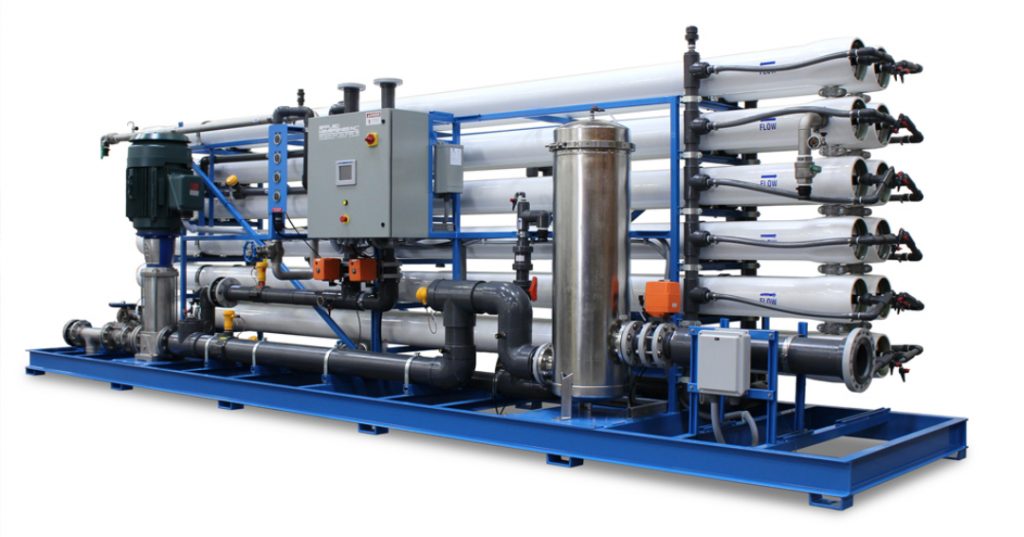What is RO?
Reverse osmosis is a membrane treatment procedure mainly to isolate dissolved solution from water. Reverse osmosis is most widely familiar for its use in drinking water purification. Remove salt and other effluents from water molecules. RO may also serve as an ultra-filter to eliminate particles that may be too large to pass through the pores of the membrane. Reverse osmosis extracts toxins or contaminants from unfiltered water. Water flows from the more contaminated or concentrated side of the RO membrane to the less contaminated or concentrated side, supplying safe and clean drinking water. The freshwater produced is permeated. The accumulated water that remains is called waste or brine.
Every reverse osmosis water system also includes sediment filters and carbon filters. These filters are prefilters or postfilter. The RO system comprises one or more of the following filters:
- Sediment Filters: Removes contaminants such as dirt, dust, and rust.
- Carbon Filters: It removes volatile organic compounds, chlorine, and other pollutants that give water a bad taste or smell.
- Semi-permeable membrane: It extracts up to 98% of the entire dissolved solids
Benefits of Reverse Osmosis
- This method is to extract several forms of dissolved and suspended chemical particles from the water
- This technique is commonly for the treatment or discharge of liquid waste.
- It is for the purification of water to avoid diseases
- It helps in the desalination of seawater
- It’s useful in the medical field.
Types of RO Filters
There are different types of reverse osmosis filters available for other needs that are as follows:
- Desalination system: Desalination is a mechanism by which solvate salts and minerals are weed out from saltwater. It is for the desalination of seawater for drinking, irrigation, etc.
- Brackish Water System: Brackish water is the salinity of water between seawater and freshwater. It is to filter or clean high salinity water.
- Water Treatment Plants: Water Treatment Plant purifies polluted products. These substances can be solid, liquid, and semi-solid. It is to disinfect a wide area of surface, brackish and seawater.
Why do we need to clean the RO Filters?
The cleaning method is an essential part of the desalination system. Membranes can become contaminated after they have been used with contaminants for some time. These pollutants may be absorbed into the membrane surface and the tubes of the membrane system. Thus, the efficiency of the system would then decrease. The system may even be badly damaged. That’s why the machine needs to be cleaned regularly.
Cleaning the reverse osmosis device is usually start when the following conditions are in place:
- The normalized flux decreased by 10-15%.
- Normalized permeate salt content increased by 10%.
- The normalized salt content of permeate increased by 10%.
Wash the semi-permeable membrane regularly. Delaying the cleaning of the membrane could severely reduce the efficiency of the membrane. If you clean and wash the membrane, then the life of the RO increases.
Steps to Clean RO Filters
Reverse Osmosis (RO) water purifiers aim to eliminate various toxins and pollutants from the water. Although, we must keep our RO filters in place to ensure that the water purifier works efficiently.

- Cut the flow of water to the storage tank.
- Empty the storage tank
- Enable the system to be free for a while and then remove the filters housing.
- Remove the Reverse Osmosis membrane and filters and replace the filter’s housing.
- There are two methods for cleaning RO Membranes. The first one is Soaking Method and the second is the Circulation Method.
- Dilute the chemicals needed to clean the reverse osmosis system.
- Clean the contaminants or chemicals found in the system.
- Clean the filter housings with a solution of soap and rinse thoroughly.
- Verify the state of the O-rings to ensure that they need to restore or replace.
- Mount the filters back and reconnect them.
- Let the tank fill up again and then drain again.
Why is RO cleaning important?
The cleaning process can vary from house to house. It completely depends on the usage and also on the quality of the water. Clean the RO filter every 3 to 12 months, depending on the RO system’s use. Routine and ongoing maintenance is essential to make the system function or run efficiently. Cleaning and maintenance can be a critical part of getting a RO water treatment system. Membranes can be affected by many pollutants, including algae, viruses, fungi, and bacteria. If we don’t clean the RO system and filters, these pollutants can affect the entire system. This can result in a complete shutdown that can have a significant effect on your activity.
If the RO membrane cleaning does not take place regularly, the device may become polluted quickly. Bacteria, which occurs naturally in water, are often a hazard to RO systems. However, it may get dirty or pollute as a result of insufficient membrane cleaning and disinfection of the system. So ongoing maintenance and support are important. It is therefore essential to approach the best company to clean membranes correctly and thoroughly.
EndNote
Cleaning and ensuring that your RO membranes and system are thoroughly and adequately cleaned is not always an easy job. Our team at Jateen Trading Co. has an expert team to help in cleaning and also to manage your RO systems. With very powerful chemicals and a specialist team, we do RO 3-way cleaning for any RO Systems.
We at Jateen Trading Co. have been one of the most renowned chemical suppliers and also one of India’s fastest-growing chemical suppliers. Moreover, we control the industrial RO parameter system and the system for different purposes. We are available to answer any kind of complaint or question about the repair or maintenance of the RO water purifier at any time. We provide the best result by regular servicing and maintenance of the RO system.

